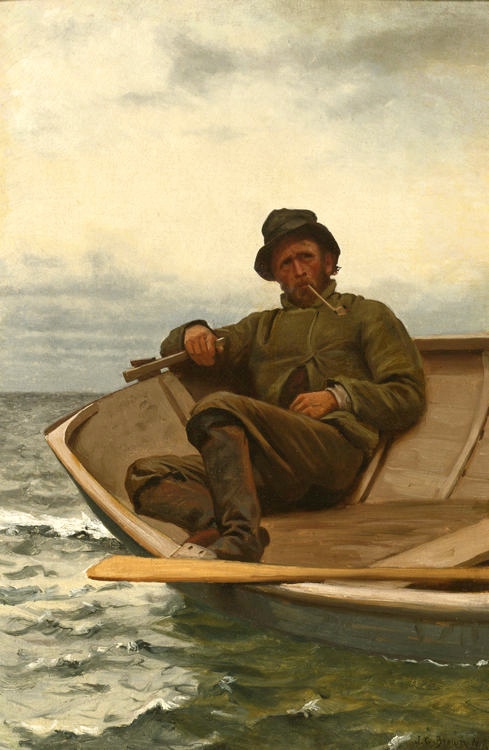"Homeward Bound" Lot no. 2739
By John George Brown 1831-1913
1878 (Estimated)
23.00" x 15.00"
Oil on Canvas
Signed Lower Right
REQUEST PRICE
PURCHASE REQUEST

Homeward Bound is a product of John George Brown’s 1877 and 1878 trips to Grand Manan Island, off the coast of Maine in the Bay of Fundy, New Brunswick, Canada. The island was popular with the American literary and artistic set of the time, including the artists Edward Moran and Alfred Thompson Bricher. While many focused on the island’s topography, a rugged shoreline bordering a body of water famous for its extreme tides, it was the unique culture of men trying to make a living within that perilous environment that captured Brown’s attention. Homeward Bound and other paintings resulting from Brown’s time at Grand Manan were executed with comparatively loose and expressive brushwork. They were often painted on location and are set apart from his characteristic urban genre paintings in their intense focus on the rugged masculinity of the subjects. Brown sought to provide a record of concurrent cultures for preservation in posterity and “Grand Manan’s isolation and traditional way of life aroused his recording instincts” (Martha Hoppin, The World of J.G. Brown, Chesterfield, 2010, p. 116). A similar composition by the same title, Homeward Bound, is currently in the collection of Historic New England, Boston, Massachusetts.
Explore related art collections: Men / Boating/Nautical / Seniors / Dark/Somber / Portraits / $50,000 - $100,000 / 1800s / Hunting/Fishing
See all original artwork by John George Brown
ABOUT THE ARTIST
Born into a poor family in Durham, England, John George Brown earned a reputation as one of 19th-century America's most skilled painters of children, especially entrepreneurial, cheerful street urchins who earned a pittance as boot blacks, newspaper vendors, etc. In some circles, he was dubbed the "Boot Black Raphael" because of the glowing faces of his child figures and his skill of execution. His paintings of these sympathy-arousing children were so popular in a Victorian era of increased industrialization that he became rich from painting sales as well as royalties from lithographs.
Brown showed early drawing talent but was discouraged by his lawyer father who insisted that he learned a trade, so he apprenticed for seven years with a glass cutter at Newcastle-On-Tyne. He worked at this trade in Edinburgh, Scotland and attended the School of the Royal Scottish Academy under Robert Scott Lauder.
At age 22, he went to London and earned a living painting portraits. Inspired by a music hall performer singing about the fascination of American life, he emigrated to Brooklyn and supported himself as a glass cutter at the Flint Glass Works in Brooklyn. His designs so impressed his employer that he helped Brown study in New York with miniaturist Thomas Cummings whose daughter Brown married.
He studied art at night at the National Academy of Design, and in May, 1856, rented his first studio, which was located in Brooklyn. In 1860, he began painting his signature portraits and juvenile figures, and in 1863, he was elected a member of the National Academy of Design. He also served as a teacher at the Academy where his classes were very popular.
To escape the pressure of his buying public and pursue other talents, he painted landscapes, some of them rural scenes including the White Mountains of New Hampshire and the Hudson River Valley with treatment of light and shadow, in the style of Albert Bierstadt and Worthington Whittredge. One of his exhibition venues was the California State Fair in 1881 and 1884.
Ask Art